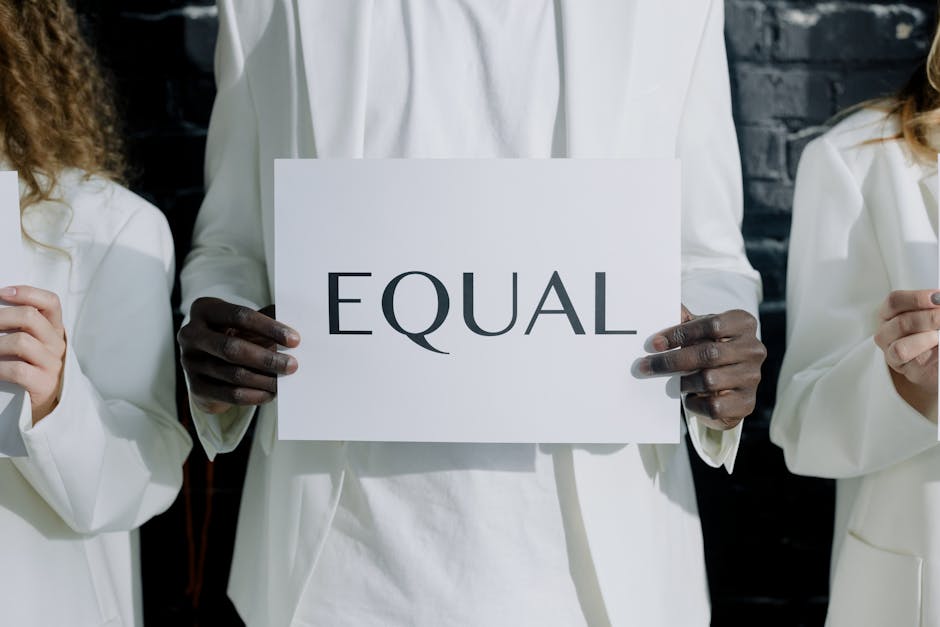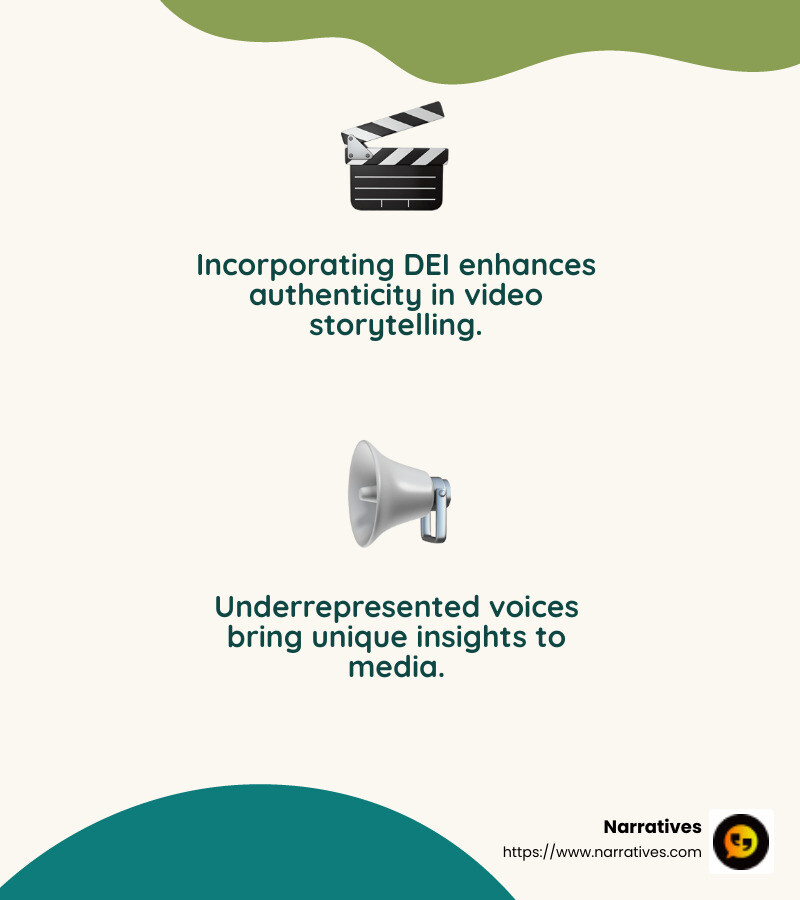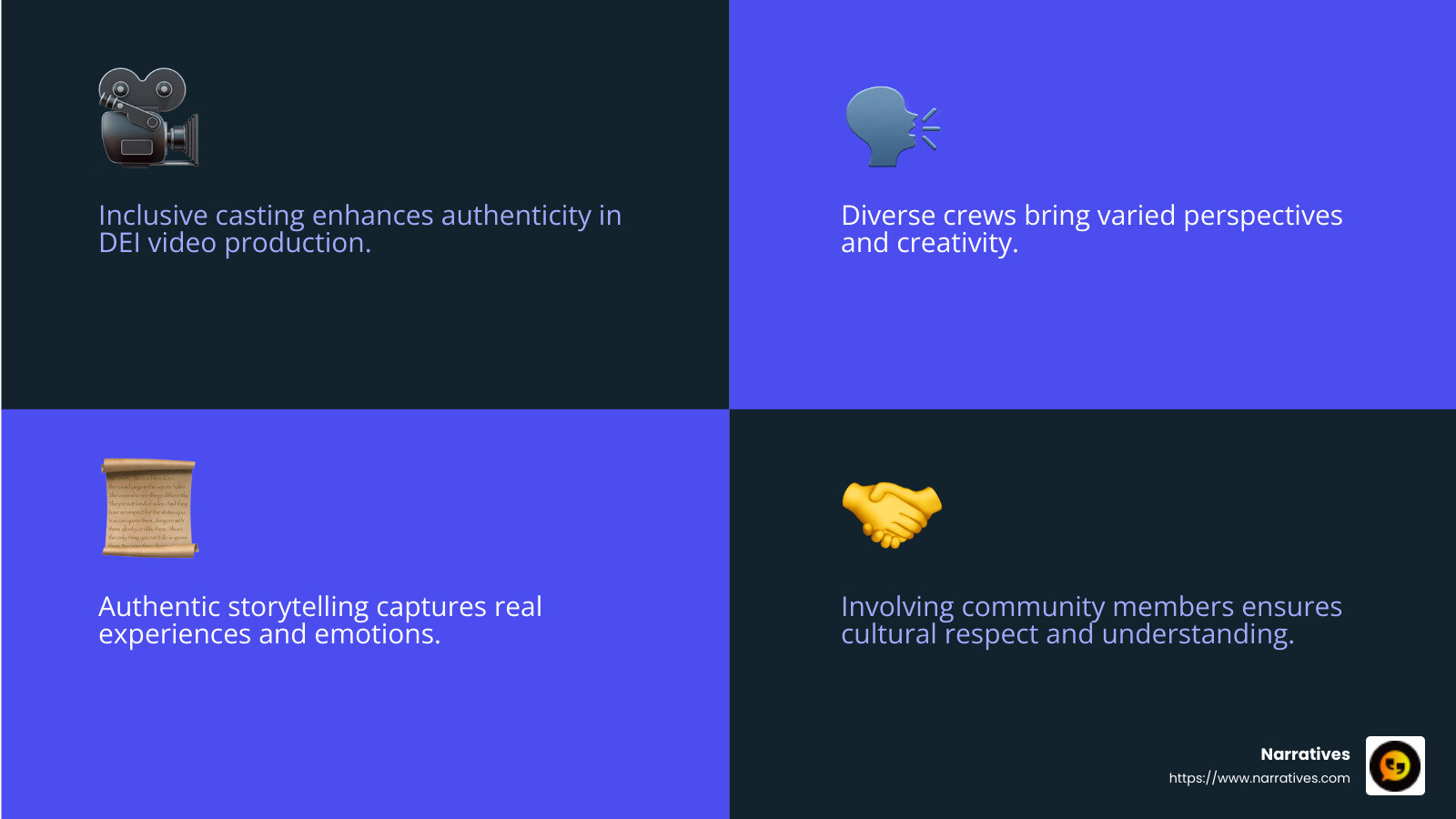Creating with Care: The Essentials of DEI Video Production

Understanding DEI Video Production
DEI video production involves crafting visual content that prioritizes diversity, equity, and inclusion. It aims to represent and give voice to different communities, ensuring everyone feels seen and heard. Key components often include:
- Diversity: Ensuring a broad spectrum of races, ethnicities, genders, abilities, and viewpoints are represented both in front of and behind the camera.
- Equity: Focusing on fair treatment, access, and opportunity within the production process to empower underrepresented groups.
- Inclusion: Creating an environment where everyone from diverse backgrounds feels welcomed and valued in the storytelling process.
Organizations increasingly understand that good storytelling requires embracing DEI principles. A quote from DEI Media Group captures this: "Incorporating diverse perspectives isn't just moral; it's a creative opportunity." This genuine commitment to understanding and accurately representing various cultures and identities is what brings authenticity and emotional impact to video content.
Organizations aiming to incorporate DEI into their narratives face lofty challenges. However, these efforts lead to meaningful engagement, wider reach, and a more equitable media landscape. As DEI Media Group puts it, “Promoting diversity, equity, and inclusion is just the beginning of a much broader strategy.” This sentiment rings true especially for non-profits and advocacy organizations, which must leverage video to resonate with values-driven audiences effectively.
The Importance of DEI in Video Production
In the field of video production, diversity, equity, and inclusion (DEI) are not just buzzwords—they are essential elements that improve authenticity and storytelling. Incorporating DEI into video production allows us to tell stories that genuinely reflect the world around us. It ensures that underrepresented voices are heard and that diverse narratives find their rightful place in the media landscape.
Authenticity in Storytelling
Authenticity is key to connecting with audiences. When video content reflects real experiences and diverse perspectives, it resonates more deeply. As noted in the research, storytelling shapes perceptions and fosters empathy. By prioritizing DEI, production companies can craft narratives that are not only true to life but also compelling and relatable.
Amplifying Underrepresented Voices
Giving a platform to underrepresented voices is crucial. It's about more than just casting diverse actors; it's about ensuring diversity behind the camera too. Directors, writers, and crew members from varied backgrounds bring unique insights, enriching the storytelling process. This approach not only challenges stereotypes but also broadens the scope of stories told.

Diverse Narratives
Diverse narratives are the backbone of impactful storytelling. They allow audiences to see themselves reflected in the content they consume. This inclusion fosters a sense of belonging and validation. As DEI becomes integral to video production, the industry moves closer to a more inclusive and equitable future.
By embedding DEI into the very fabric of video production, we create content that is not only engaging but also transformative. This commitment to diversity, equity, and inclusion is what will drive the industry forward, ensuring that stories resonate with audiences far and wide.
Key Strategies for Effective DEI Video Production
Creating DEI video production that truly resonates with audiences requires thoughtful strategies. These strategies encompass storytelling approaches, casting decisions, and fostering an inclusive environment.
Storytelling Approaches
Storytelling is the heart of any video production. To effectively integrate DEI, stories must be crafted with care and intention. This means going beyond surface-level diversity to explore deeper, more nuanced narratives. Authentic storytelling is about capturing real experiences and emotions that reflect the diverse world we live in.
For instance, a video project might focus on the journey of an entrepreneur from an underrepresented community, highlighting their challenges and triumphs. This not only tells an engaging story but also provides a platform for voices that are often overlooked.
Casting Decisions
Casting is a crucial element of DEI video production. It's essential to cast individuals who genuinely represent the characters and communities being portrayed. This goes beyond just appearance; it includes understanding and respecting cultural nuances and experiences.
Consider this: When casting for a role that represents a specific community, involve members of that community in the casting process. This ensures authenticity and respect, and it enriches the narrative by incorporating diverse perspectives.
Inclusive Environment
Creating an inclusive environment on set is vital for the success of any DEI-focused project. This means having a diverse crew and fostering a culture where everyone feels valued and heard. A diverse team brings varied experiences and insights, enhancing creativity and problem-solving.

Building inclusivity also involves implementing policies and practices that support diversity, such as inclusive hiring practices and providing development opportunities for underrepresented groups. By doing so, production companies can ensure that the stories they tell are authentic and resonate with a wide audience.
By focusing on these strategies, video production teams can create content that not only entertains but also informs and inspires. This approach not only benefits the industry but also contributes to a more inclusive and equitable society.
DEI Video Production Techniques
Creating impactful DEI video production involves several key techniques that ensure the content is both meaningful and effective. These techniques include repurposing footage, maintaining high-quality content, and ensuring emotional resonance.
Repurposing Footage
One practical approach to DEI video production is repurposing existing footage. This is not just a cost-effective method, but it also maximizes the return on investment from previous projects. By using footage filmed for past videos, like those created for SCORE's DEI initiatives, producers can craft new narratives that align with current DEI goals.
Repurposing also reduces the need for in-person filming, which is particularly beneficial during uncertain times, such as during a pandemic. This approach allows for flexibility and creativity, enabling producers to weave together diverse stories without the constraints of new filming.
High-Quality Content
High-quality content is essential for any video production, especially when focusing on DEI. Quality goes beyond visual appeal; it includes the strategic execution of elements like lighting, sound, and direction. These elements lift a project from ordinary to extraordinary, ensuring that the message is clearly communicated and resonates with the audience.
In post-production, attention to detail is crucial. Perfect color grading, intentional effects, and thoughtful typography contribute to a polished final product. The music score should not just accompany the visuals but improve the narrative, creating a cohesive and powerful story that aligns with the project's DEI objectives.
Emotional Resonance
For DEI video production to be truly effective, it must evoke an emotional response. Emotional resonance is achieved by telling authentic stories that reflect real experiences and emotions. This involves showcasing diverse narratives that audiences can connect with on a personal level.
For example, a video highlighting the journey of an underrepresented entrepreneur not only tells their story but also allows viewers to empathize with their challenges and successes. This connection fosters a deeper understanding and appreciation of diverse perspectives.
To create such emotional impact, producers should focus on capturing genuine moments and emotions, ensuring that the stories told are both relatable and inspiring. This approach not only engages viewers but also promotes a more inclusive and equitable society.
By incorporating these techniques, video production teams can create DEI content that is not only visually stunning but also meaningful and impactful. This leads directly into the next section, where we explore the role of DEI in non-profit storytelling, emphasizing social impact and community-driven narratives.
The Role of DEI in Non-Profit Storytelling
Non-profit storytelling is a powerful tool for driving social impact. By integrating diversity, equity, and inclusion (DEI) into their narratives, non-profits can amplify their mission and reach broader audiences. This approach not only improves their storytelling but also strengthens their connection with the communities they serve.
Social Impact
DEI-driven storytelling in non-profits is about more than just sharing stories; it's about creating real change. Non-profits like Pars Equality Center use DEI principles to craft narratives that highlight the challenges and triumphs of underrepresented groups, such as Persian-speaking immigrants. By showcasing these stories, they raise awareness and inspire action, ultimately driving social change.
Stories that focus on social impact are not just informative; they are transformative. They have the power to shift perceptions, challenge stereotypes, and encourage empathy. This kind of storytelling is essential for non-profits aiming to make a lasting impact on society.
Community-Driven Storytelling
Community-driven storytelling is at the heart of effective DEI video production for non-profits. By involving community members in the storytelling process, non-profits ensure that the narratives are authentic and representative of the people they serve. This approach fosters trust and engagement, as community members see their voices and experiences reflected in the stories.
For instance, Narratives works closely with non-profits to create content that highlights the communities they serve. By focusing on real stories from real people, they create videos that resonate with audiences on a personal level. This not only lifts the organization's mission but also empowers the community by giving them a platform to share their stories.
Purpose-Driven Organizations
Purpose-driven organizations understand that storytelling is a key component of their DEI strategy. By aligning their narratives with their mission, these organizations can effectively communicate their values and goals. This alignment is crucial for building a strong brand identity and fostering loyalty among supporters.
Non-profits that prioritize DEI in their storytelling are better equipped to connect with diverse audiences. They demonstrate a commitment to inclusivity, which can improve their reputation and increase their impact. By telling stories that reflect their purpose, these organizations inspire others to join their cause and support their mission.
In summary, DEI plays a crucial role in non-profit storytelling by driving social impact, fostering community engagement, and aligning with organizational purpose. This leads us into the next section, where we will address frequently asked questions about DEI video production and its significance in amplifying underrepresented voices and enhancing non-profit visibility.
Frequently Asked Questions about DEI Video Production
What is DEI in video production?
DEI in video production stands for diversity, equity, and inclusion. It means creating content that represents different groups of people fairly and authentically. This involves showcasing diverse stories, characters, and perspectives in videos. By doing so, video producers ensure that everyone feels seen and heard. DEI is crucial for making videos that reflect the real world and connect with a wide audience.
How can video production amplify underrepresented voices?
Video production can be a powerful tool to amplify underrepresented voices by telling stories that might not otherwise be heard. By focusing on authentic characters and diverse communities, videos can shine a light on experiences that are often overlooked. For example, organizations like SCORE use DEI principles to create videos that highlight the journeys of diverse entrepreneurs. This not only gives visibility to these voices but also inspires others by showing what's possible.
By involving people from underrepresented groups in the storytelling process, video producers can ensure the content is genuine and impactful. This approach fosters trust and engagement, as audiences see their own experiences reflected in the stories.
Why is DEI important for non-profits?
For non-profits, DEI is essential in building trust, visibility, and impactful stories. When non-profits incorporate DEI in their videos, they demonstrate a commitment to inclusivity and fairness. This helps build trust with their audience and the communities they serve. People are more likely to support organizations that value diversity and represent them accurately.
DEI-focused videos also increase visibility by reaching a broader audience. By telling stories that resonate with diverse viewers, non-profits can expand their reach and influence. This is crucial for raising awareness and driving support for their mission.
Finally, DEI helps non-profits create impact stories that inspire change. By highlighting the challenges and successes of underrepresented groups, these stories can motivate action and foster empathy. Non-profits like Narratives use DEI-driven storytelling to make a real difference in the communities they serve.
Conclusion
At Narratives, we believe in the power of digital storytelling to drive meaningful change. By partnering with non-profits and purpose-driven organizations, we help amplify voices that often go unheard. Our focus on DEI video production ensures that every story we tell is authentic, inclusive, and impactful.
Non-profits have a unique opportunity to lead the charge in promoting diversity, equity, and inclusion. Through our collaborative approach, we work with these organizations to craft stories that not only resonate with their audiences but also inspire action and build trust. By showcasing the real-life experiences of diverse communities, we help non-profits increase their visibility and strengthen their connection with supporters.
Where audiences demand content that reflects the rich mix of human experience, it's more important than ever to get DEI right. By telling stories that matter, we can foster empathy and understanding—key ingredients for positive social change.
Narratives is committed to being your trusted partner in this journey. Together, let's create content that not only informs but transforms, making the world a more inclusive and equitable place for all.


